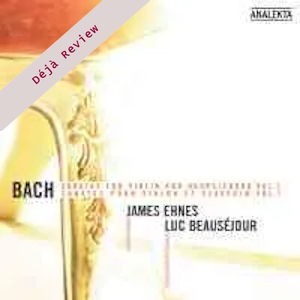
Déjà Review: this review was first published in March 2005 and the recording is still available.
Johann Sebastian Bach (1685-1750)
Sonatas for Violin and Harpsichord Volume I
Sonata No. 1 in b minor BWV 1014
Sonata No. 2 in A Major BWV 1015
Sonata No. 3 in E Major BWV 1016
Sonata No. 4 in c minor BWV 1017
James Ehnes (violin)
Luc Beauséjour (harpsichord)
rec. 2004, Domaine Forget, Canada
Analekta AN29829 [59]
Sebastian Bach’s six sonatas for violin and harpsichord, although missing the single line bass instrument, are in fact trio sonatas in form, and surviving copies (Bach’s originals have been lost) title the works as “trios.” In this case the harpsichord provides the two lower voices.
There are dozens of fine recordings of these works, spanning over a fifty year period or more, so it takes something special to make yet another new recording of them of interest. This performance succeeds in that regard not so much by what these artists do, but in what they do not do. To wit, many performances that I have heard in the past rely on overly maudlin interpretations of the slow movements (especially the largo of BWV 1017 which was to reappear as the aria Erbarme dich in the St. Matthew Passion,) and to be too overtly virtuosic in the faster movements.
Ehnes and Beauséjour eschew the tendency to be too romantic and play these works with a marvelous combination of serenity, spirituality and joy. Although he plays a modern violin, James Ehnes is quite sensitive to baroque performance practice, avoiding heavy vibrato and playing with what sounds to me like a lighter bow arm, not bearing down on the strings so hard as to make the sound Brahmsian, for example. Mr. Beauséjour is a fine duo partner, fleet of finger and producing a rich tone and fine accompaniment to Ehnes’ lovely cantabile. Both gentlemen get around quite adroitly in the faster movements as well.
I was also impressed that the recording engineers did not mic the harpsichord too closely, thus avoiding the unnatural sound that often results in studio recordings of this instrument. There was one strange technical glitch in my review copy that must be noted however. The information that is encoded in the disc that gives me a display of the work title and artist was misencoded, and the tracking information that appeared on my CD player’s screen was for a completely different disc. This little flaw will hopefully be corrected in the next run.
That little error aside, this is a very fine release indeed, and Analekta continue to take a strong place in the lineup of consistent and outstanding record labels. I do wish, however, that their booklet notes were a bit more detailed, and more geared toward an educated audience. Not that these notes are poorly written, they just seem only to scratch the surface, when more detail and analysis would be appreciated.
As goes the performance though, this is one of the best chamber music recordings to which I have listened this year, a disc that will have pride of place on my shelf and one that is sure to get repeated listening.
Kevin Sutton
Help us financially by purchasing from




















